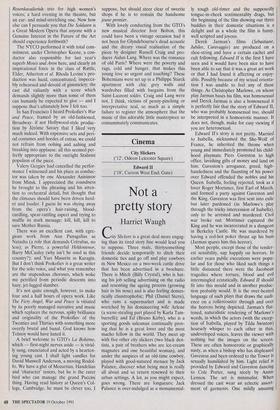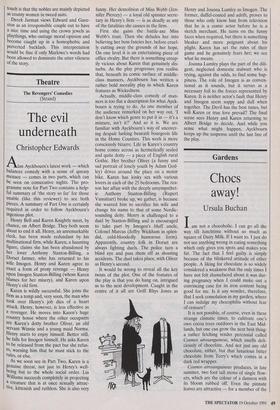Cinema
City Slickers ('12', Odeon Leicester Square) Edward II ('18', Curzon West End; Gate)
Not a pretty story
Harriet Waugh
City Slickers is a great deal more engag- ing than its tired story line would lead you to suppose. Three male, thirtysomething friends decide temporarily to ditch their domestic ties and go off and play cowboys in New Mexico on a two-week cattle drive that has been advertised in a brochure. There is Mitch (Billy Crystal), who is hat- ing his job selling advertising on the radio and resenting the ageing process (growing hair in his nose) and is also feeling domes- tically claustrophobic; Phil (Daniel Stern), who runs a supermarket and is made wretched by his domineering wife Arlene (a scene-stealing part played by Karla Tam- burrelli); and Ed (Bruno Kirby), who is a sporting goods salesman continually prov- ing that he is a great lover and the most macho fellow in the world. They meet up with five other city slickers (two black den- tists, a pair of brothers who are ice-cream magnates and one beautiful woman), and under the auspices of an old-time cowboy, played with good-natured menace by Jack Palance, discover what being men is really all about and so return renewed to their urban settings. A lot, as you might expect, goes wrong. There are longueurs; Jack Palance is over-indulged as a monumental-
ly tough old-timer and the supposedly tongue-in-cheek sentimentality drags, but the beginning of the film showing our three buddies in their domestic situations is a delight and as a whole the film is funny, well scripted and joyous.
Derek Jarman's films (Sebastiane, Jubilee, Caravaggio) are produced on a shoe-string and have a certain cachet and cult following. Edward II is the first I have seen and it would have been nice to have been able to say that it was a great art work or that I had found it affecting or enjoy- able. Possibly because of my sexual orienta- tion I was unable to feel any of these things. As Christopher Marlowe, on whose play Jarman bases his film, was homosexual and Derek Jarman is also a homosexual it is perfectly fair that the story of Edward II, who was probably homosexual too, should be interpreted in a homoerotic manner. It does not, though, make for easy viewing if you are heterosexual.
Edward II's story is not pretty. Married to Isabella, nicknamed the She-Wolf of France, he inherited the throne when young and immediately promoted his child- hood playmate Piers Gaveston to high office, lavishing gifts of money and land on him. Gaveston's arrogance, greed, high- handedness and the flaunting of his power over Edward offended the nobles and his Queen. Isabella, feeling rejected, took as a lover Roger Mortimer, first Earl of March, and formed a party against Gaveston and the King. Gaveston was first sent into exile but later pardoned (in Marlowe's play through the tricky intercession of Isabella), only to be arrested and murdered. Civil war broke out. Mortimer captured the King and he was incarcerated in a dungeon in Berkeley Castle. He was murdered by having a red-hot poker thrust up his bum (Jarman spares him this horror).
Most people, except those of the tender- est sensibility, sup happily on horrors. In earlier years public executions were popu- lar and for those who liked such things a little distanced there were the Jacobean tragedies where torture, blood and evil intermingled ecstatically. Edward II should fit into this mould and in another produc- tion probably would. It is the over-heated language of such plays that draws the audi- ence on a rollercoaster through and over the horrors being depicted. Jarman's flat- tened, naturalistic rendering of Marlowe's words, in which the actors (with the excep- tion of Isabella, played by Tilda Swinton) hoarsely whisper to each other in thin, undeveloped voices, leaves the viewer with nothing but the images on the screen. These are often hornoerotic or graphically nasty, as when a bishop who has displeased Gaveston and been ordered to the Tower is sexually humiliated by him. Light relief is provided by Edward and Gaveston dancing to Cole Porter, sung nicely by Annie Lennox. The set is minimalist. When dressed the cast wear an eclectic assort- ment of garments. One mildly amusing
touch is that the nobles are mainly depicted as county women in tweed suits.
Derek Jarman views Edward and Gave- ston as an irresponsible couple out to have a nice time and using the crown jewels as Playthings, who outrage moral opinion and become caught up in a homophobic and perverted backlash. This interpretation would be fine if only Marlowe's words had been allowed to dominate the utter vileness of the story.



























































 Previous page
Previous page